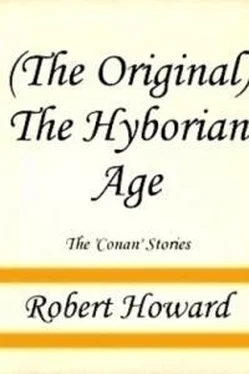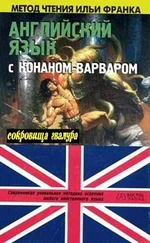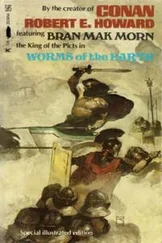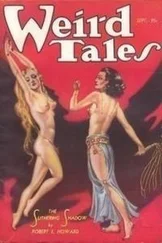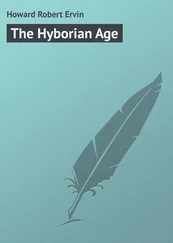In the north, golden–haired, blue–eyed barbarians, descendants of the blond arctic savages, have driven the remaining Hyborian tribes out of the snow countries, except the ancient kingdom of Hyperborea, which resists their onslaught. Their country is called Nordheim, and they are divided into the red–haired Vanir of Vanaheim, and the yellow–haired Æsir of Asgard.
Now the Lemurians enter history again as Hyrkanians. Through the centuries they have pushed steadily westward, and now a tribe skirts the southern end of the great inland sea—Vilayet—and establishes the kingdom of Turan on the southwestern shore. Between the inland sea and the eastern borders of the native kingdoms lie vast expanses of steppes and in the extreme north and extreme south, deserts. The non–Hyrkanian dwellers of these territories are scattered and pastoral, unclassified in the north, Shemitish in the south, aboriginal, with a thin strain of Hyborian blood from wandering conquerors. Toward the latter part of the period other Hyrkanian clans push westward, around the northern extremity of the inland sea, and clash with the eastern outposts of the Hyperboreans.
Glance briefly at the peoples of that age. The dominant of Hyborians are no longer uniformly tawny–haired and grey–eyed. They have mixed with other races. There is a strong Shemitish, even a Stygian strain among the peoples of Koth, and to a lesser extent, of Argos, while in the case of the latter, admixture with the Zingarans has been more extensive than with the Shemites. The eastern Brythunians have intermarried with the dark–skinned Zamorians, and the people of southern Aquilonia have mixed with the brown Zingarans until black hair and brown eyes are the dominant type in Poitain, the southern–most province. The ancient kingdom of Hyperborea is more aloof than the others, yet there is alien blood in plenty in its veins, from the capture of foreign women—Hyrkanians, Æsir and Zamorians. Only in the province of Gunderland, where the people keep no slaves, is the pure Hyborian stock found unblemished. But the barbarians have kept their bloodstream pure; the Cimmerians are tall and powerful, with dark hair and blue or grey eyes. The people of Nordheim are of similar build, but with white skins, blue eyes and golden or red hair. The Picts are of the same type as they always were—short, very dark, with black eyes and hair. The Hyrkanians are dark and generally tall and slender, though a squat slant–eyed type is more and more common among them, resulting from mixture with a curious race of intelligent, though stunted, aborigines, conquered by them among the mountains east of Vilayet, on their westward drift. The Shemites are generally of medium height, though sometimes when mixed with Stygian blood, gigantic, broadly and strongly built, with hook noses, dark eyes and blue–black hair. The Stygians are tall and well made, dusky, straight–featured—at least the ruling classes are of that type. The lower classes are a down–trodden, mongrel horde, a mixture of negroid, Stygian, Shemitish, even Hyborian bloods. South of Stygia are the vast black kingdoms of the Amazons, the Kushites, the Atlaians and the hybrid empire of Zembabwe.
Between Aquilonia and the Pictish wilderness lie the Bossonian marches, peopled by descendants of an aboriginal race, conquered by a tribe of Hyborians, early in the first ages of the Hyborian drift. This mixed people never attained the civilization of the purer Hyborians, and was pushed by them to the very fringe of the civilized world. The Bossonians are of medium height and complexion, their eyes brown or grey, and they are mesocephalic. They live mainly by agriculture, in large walled villages, and are part of the Aquilonian kingdom. Their marches extend from the Border Kingdom in the north to Zingara in the southwest, forming a bulwark for Aquilonia against both the Cimmerians and the Picts. They are stubborn defensive fighters, and centuries of warfare against northern and western barbarians have caused them to evolve a type of defense almost impregnable against direct attack.
Five hundred years later the Hyborian civilization was swept away. Its fall was unique in that it was not brought about by internal decay, but by the growing power of the barbarian nations and the Hyrkanians. The Hyborian peoples were overthrown while their vigorous culture was in its prime.
Yet it was Aquilonia's greed which brought about that overthrow, though indirectly. Wishing to extend their empire, her kings made war on their neighbors. Zingara, Argos and Ophir were annexed outright, with the western cities of Shem, which had, with their more eastern kindred, recently thrown off the yoke of Koth. Koth itself, with Corinthia and the eastern Shemitish tribes, was forced to pay Aquilonia tribute and lend aid in wars. An ancient feud had existed between Aquilonia and Hyperborea, and the latter now marched to meet the armies of her western rival. The plains of the Border Kingdom were the scene of a great and savage battle, in which the northern hosts were utterly defeated, and retreated into their snowy fastnesses, whither the victorious Aquilonians did not pursue them. Nemedia, which had successfully resisted the western kingdom for centuries, now drew Brythunia and Zamora, and secretly, Koth, into an alliance which bade fair to crush the rising empire. But before their armies could join battle, a new enemy appeared in the east, as the Hyrkanians made their first real thrust at the western world. Reinforced by adventurers from east of Vilayet, the riders of Turan swept over Zamora, devastated eastern Corinthia, and were met on the plains of Brythunia by the Aquilonians who defeated them and hurled them flying eastward. But the back of the alliance was broken, and Nemedia took the defensive in future wars, aided occasionally by Brythunia and Hyperborea, and, secretly, as usual, by Koth. This defeat of the Hyrkanians showed the nations the real power of the western kingdom, whose splendid armies were augmented by mercenaries, many of them recruited among the alien Zingarans, and the barbaric Picts and Shemites. Zamora was reconquered from the Hyrkanians, but the people discovered that they had merely exchanged an eastern master for a western master. Aquilonian soldiers were quartered there, not only to protect the ravaged country, but also to keep the people in subjection. The Hyrkanians were not convinced; three more invasions burst upon the Zamorian borders, and the Lands of Shem, and were hurled back by the Aquilonians, though the Turanian armies grew larger as hordes of steel–clad riders rode out of the east, skirting the southern extremity of the inland sea.
But it was in the west that a power was growing destined to throw down the kings of Aquilonia from their high places. In the north there was incessant bickering along the Cimmerian borders between the black–haired warriors and the Nordheimir; and the Æsir, between wars with the Vanir, assailed Hyperborea and pushed back the frontier, destroying city after city. The Cimmerians also fought the Picts and Bossonians impartially, and several times raided into Aquilonia itself, but their wars were less invasions than mere plundering forays.
But the Picts were growing amazingly in population and power. By a strange twist of fate, it was largely due to the efforts of one man, and he an alien, that they set their feet upon the ways that led to eventual empire. This man was Arus, a Nemedian priest, a natural–born reformer. What turned his mind toward the Picts is not certain, but this much is history—he determined to go into the western wilderness and modify the rude ways of the heathen by the introduction of the gentle worship of Mitra. He was not daunted by the grisly tales of what had happened to traders and explorers before him, and by some whim of fate he came among the people he sought, alone and unarmed, and was not instantly speared.
Читать дальше
